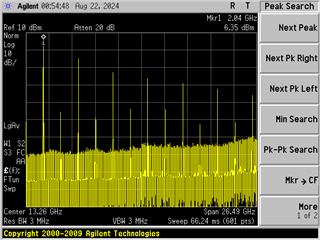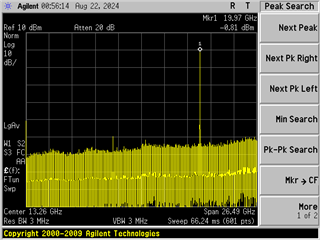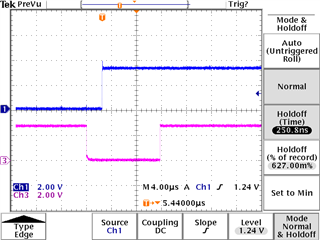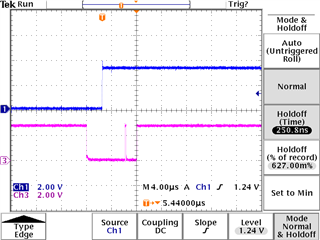Tool/software:
A similar question has already been asked before: https://e2e.ti.com/support/clock-timing-group/clock-and-timing/f/clock-timing-forum/1028354/lmx2820-mux_out_doubler-issue-in-fast-vco-mode
No useful answer was given. So I am going to ask one more time:
We set the frequency at 5.65GHz and complete the Instant Calibration.The whole precedure is as below. After the calibration, we can set any frequecy below 11.3GHz and the switching time between two freq points is very short.
Initialization register setting
1. Set DBLBUF_PLL_EN, DBLBUF_CHDIV_EN, DBLBUF_OUTBUF_EN, DBLBUF_OUTMUX_EN = 1
2. Set DBLR_CAL_EN = 0; INSTCAL_SKIP_ACAL = 0
3. If VCO doubler is required, set INSTCAL_DBLR_EN = 1, otherwise set this bit to 0
4. Set INSTCAL_DLY = T x fosc (in MHz) / 2^CAL_CLK_DIV, where T = 2.5 x CBIASVCO / 0.47µF. CBIASVCO is the bypass capacitor at pin 3
5. Configure other registers to lock to 5.65GHz without any calibration assist
6. Set INSTCAL_PLL_NUM = 2^32 x (PLL_NUM / PLL_DEN)
Programming
7. Vcc power up LMX2820
8. Program all the registers, LMX2820 should lock to 5.65GHz
InstCal calibration
9. Program INSTCAL_EN = 1
9.5 run Index routine
10. Program R0 (with FCAL = 1), calibration will begin
11. Wait 100ms
12. Program R0 (with FCAL = 0) to complete the calibration
But when we change the frequency to above 11.3GHz, we found two points:
1.When we set as below, disable the tracking filter(with DBLR_CAL_EN=0), the output power will be lost in some frequency area between 11GHz to 19GHz, it is showed in the pic.
a. Program INSTCAL_PLL_NUM, PLL_N, PLL_NUM and PLL_DEN (if their value have change)
b. Program R0 (with FCAL = 0, DBLR_CAL_EN = 0) to change VCO frequency

2.When we set as below, enable the tracking filter(with DBLR_CAL_EN=1), the Frequency Lock indicator LD signal will remain to low when we swtich the frequency point in a very tiny time, just like several hundreds of microseconds.
a. Program INSTCAL_PLL_NUM, PLL_N, PLL_NUM and PLL_DEN (if their value have change)
b. Program R0 (with FCAL = 0, DBLR_CAL_EN = 0) to change VCO frequency
Can anyone help to solve the problem when we want to quickly switching the frequency points between 2GHz to 20GHz. Thanks a lot.






